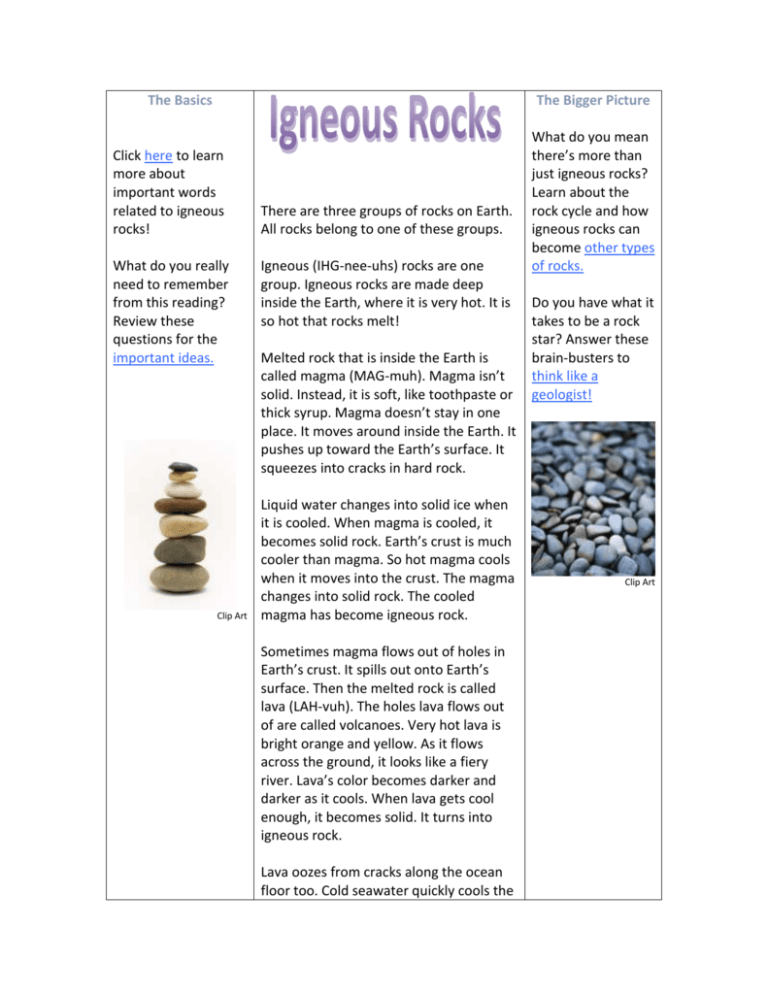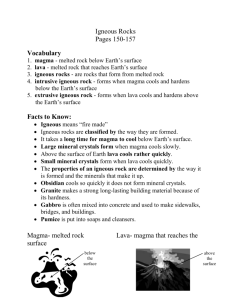reading passage. - Personal.kent.edu
advertisement

The Basics The Bigger Picture Click here to learn more about important words related to igneous rocks! What do you really need to remember from this reading? Review these questions for the important ideas. Clip Art There are three groups of rocks on Earth. All rocks belong to one of these groups. Igneous (IHG-nee-uhs) rocks are one group. Igneous rocks are made deep inside the Earth, where it is very hot. It is so hot that rocks melt! Melted rock that is inside the Earth is called magma (MAG-muh). Magma isn’t solid. Instead, it is soft, like toothpaste or thick syrup. Magma doesn’t stay in one place. It moves around inside the Earth. It pushes up toward the Earth’s surface. It squeezes into cracks in hard rock. Liquid water changes into solid ice when it is cooled. When magma is cooled, it becomes solid rock. Earth’s crust is much cooler than magma. So hot magma cools when it moves into the crust. The magma changes into solid rock. The cooled magma has become igneous rock. Sometimes magma flows out of holes in Earth’s crust. It spills out onto Earth’s surface. Then the melted rock is called lava (LAH-vuh). The holes lava flows out of are called volcanoes. Very hot lava is bright orange and yellow. As it flows across the ground, it looks like a fiery river. Lava’s color becomes darker and darker as it cools. When lava gets cool enough, it becomes solid. It turns into igneous rock. Lava oozes from cracks along the ocean floor too. Cold seawater quickly cools the What do you mean there’s more than just igneous rocks? Learn about the rock cycle and how igneous rocks can become other types of rocks. Do you have what it takes to be a rock star? Answer these brain-busters to think like a geologist! Clip Art lava. Sometimes the lava hardens into round, pillow-shaped rocks. As melted rock cools, the minerals it is made of may for crystals (KRIHS-tuhlz). Crystals are solid shapes. They have many flat surfaces. Each flat surface is called a face. Some igneous rocks have many flat, shiny bits in them. The shiny bits are crystal faces. It takes time for a crystal to form. When a crystal begins to form, it is very tiny. Slowly, the crystal grows bigger. The crystals in an igneous rock tell us about the melted rock it was made from. Sometimes melted rock cools slowly. Other times, melted rock cools quickly. Crystals can help you figure out whether a rock cooled slowly or quickly. Some igneous rocks have large crystals. What does that tell you? It tells you that these rocks cooled slowly. The crystals had a lot of time to grow. Other igneous rocks have tiny crystals. Can you guess what that means? It means that these rocks cooled more quickly. The crystals did not have time to grow big. Some igneous rocks have no crystals at all. They cooled so quickly that crystals didn’t have time to start growing. One kind of igneous rock is called obsidian (ahb-SIH-dee-uhn). It is as smooth as glass. Obsidian has no crystals at all. Do you think obsidian forms quickly when lava cools slowly or when it cools quickly? Third Grade Science Walker, Sally M. (2007). Rocks. Minneapolis: Lerner Publications Company. Elissa Lawrence







